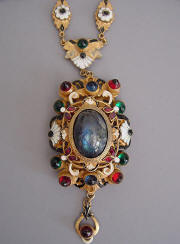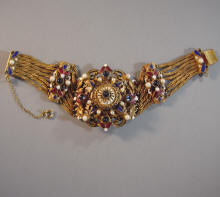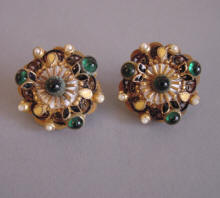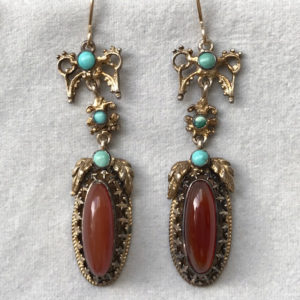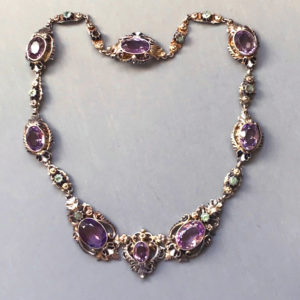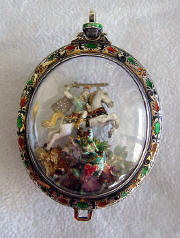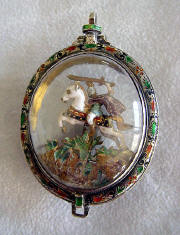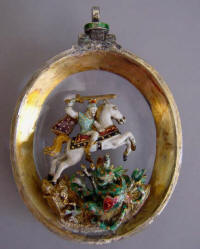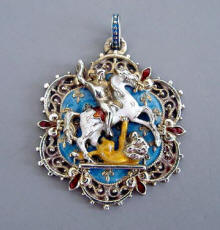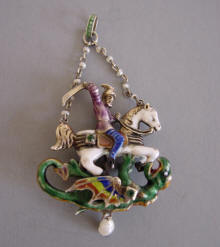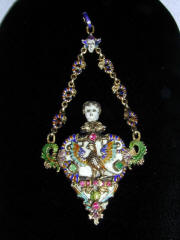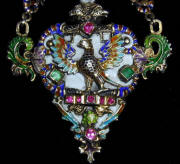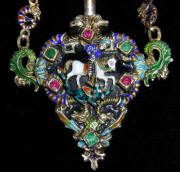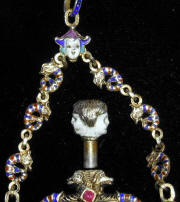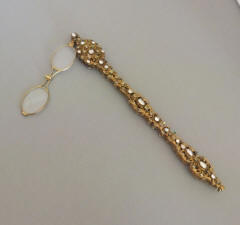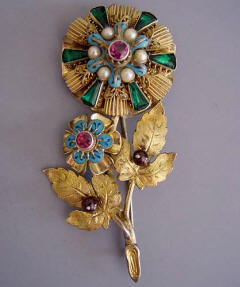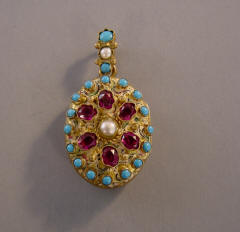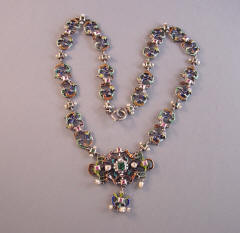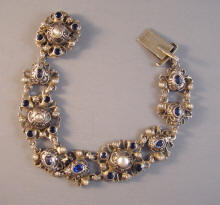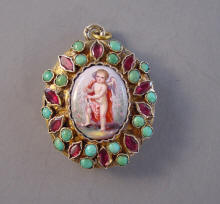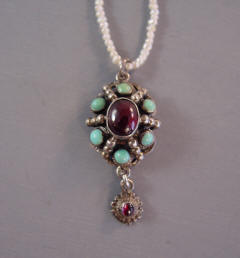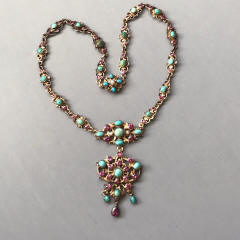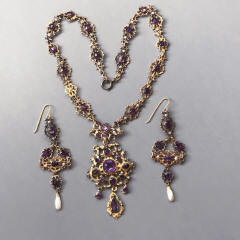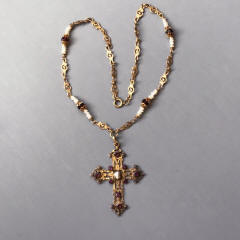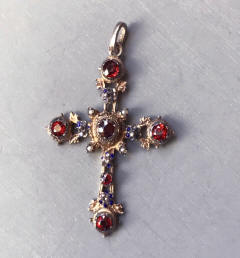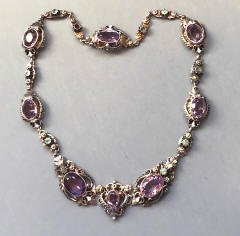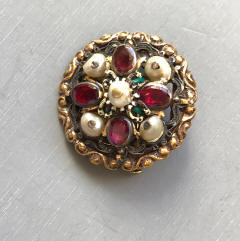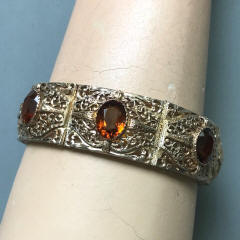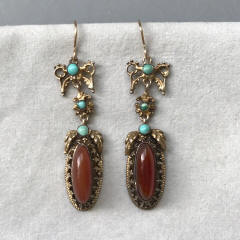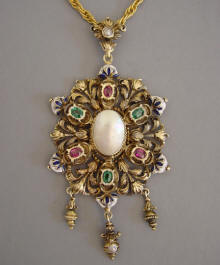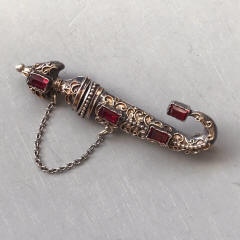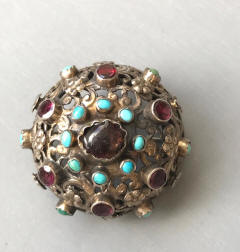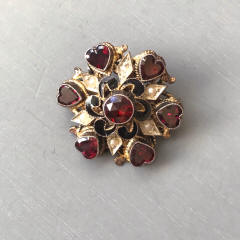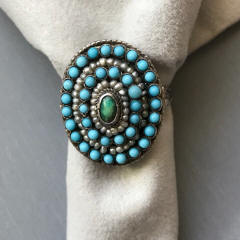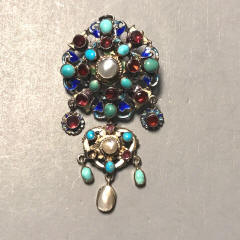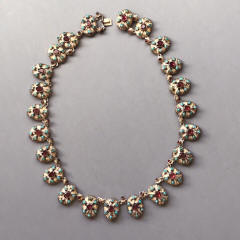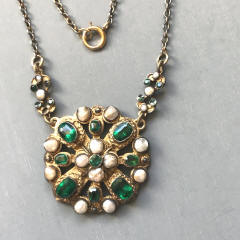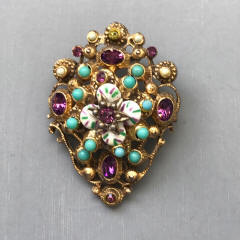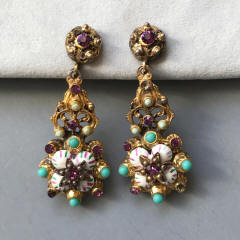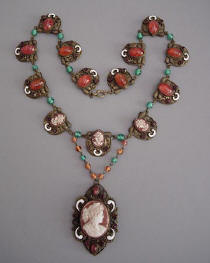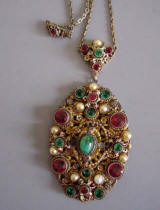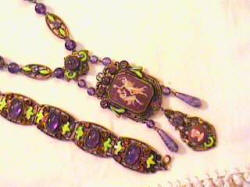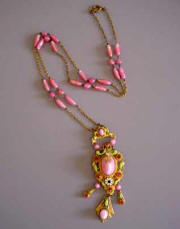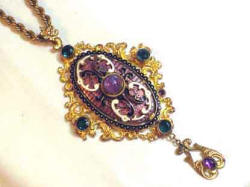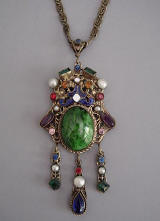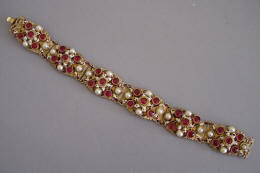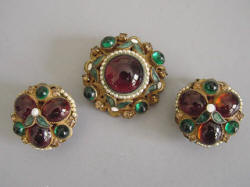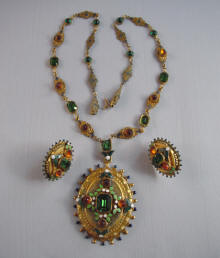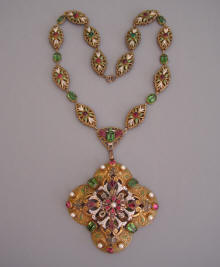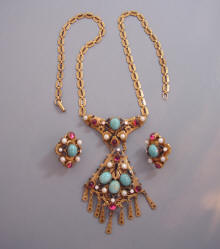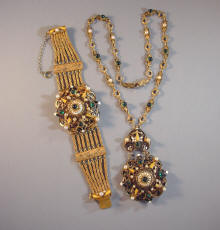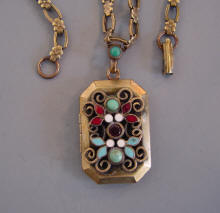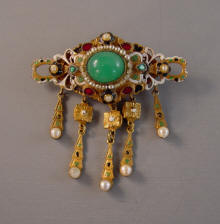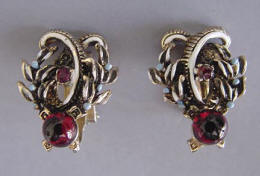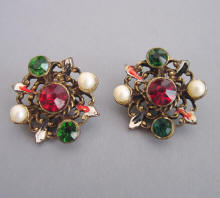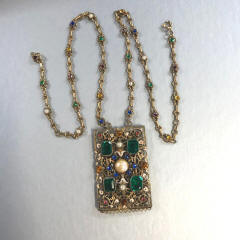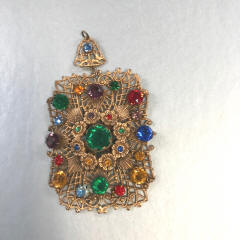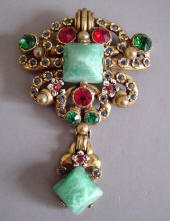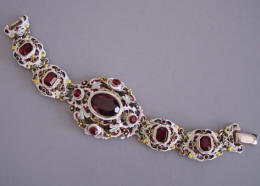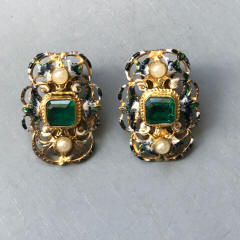|
|
|
Morning Glory Collects…
things we love to buy, wear and share
Austro-Hungarian/Renaissance Revival/Czech Jewelry
and St. George and the Dragon
|

|
|
St. George & the Dragon
The first piece of Austro-Hungarian work I ever purchased is the
first piece shown below, the enameled St. George in rock crystal egg
shape. It fascinated me the moment I saw it. The motif in this piece is
St. George and the Dragon
encased in a rock crystal orb or egg surrounded by an intricately
enameled and hinged frame. Although it looks at first glance like a
pendant, it is really too heavy for that and the fitting at the top has
such a tiny hole for a bail that I doubt that any chain is fine enough to pass through
it.
I am not sure what this was used for, if it is jewelry or an ornament of
some kind. It does look
a bit like part of the insignia of the
Order of the Garter, and the
Order of
the Garter is an English Order of Chivalry. It started my
interest in Austro-Hungarian and St. George jewelry many years ago.
The jewelry seems to fall into three major categories: the antique
Austro-Hungarian pieces 1867-1918; the Austro-Hungarian Revival; and the
Austro-Hungarian inspired pieces including pieces made in a similar style by
20th century jewelry companies like Hobe.
The quality
of these pieces varies widely. In general the older the
piece is, the better the quality. The older pieces often use genuine stones with varied quality while the later ones use paste and rhinestones. The
enamel work also varies widely in quality, again with the older being
the best with the most clean detail and tiny line work. Some of the older pieces
even have tiny areas of enamel work on the loop for the chain, a great
detail. Not all pieces are marked
but when the 18th century pieces do have a mark, the hallmarks can be so tiny that they
are all but impossible to find, so you have to look carefully and usually
with magnification.
Austro-Hungary was an important power in Central Europe, ruled from 1867 to
1918 by the House of Habsburg. Read more about it’s interesting
history on WIKI by clicking
HERE.
|
|
ST. GEORGE and the Dragon
pendant or ornament,
2-1/3" by 1-5/8" by 1-3/4" deep. This is an enameled figure encased in
a hinged rock
crystal case. All the
pieces within the rock crystal "egg" are poly-chrome enamel and three dimensional.
The enameling is orange, black and green around the outside edges, and the
figures are purple, blue, green, orange and black. The piece is almost as deep
as it is wide. The square jump ring is typical of the 18th century, but I am
still researching date and provenance. As can be seen in the pictures, the hinge
is broken. View
View
View
View
View
View
#V22499
|
St. GEORGE and the DRAGON-
Reverse view This
has a hinge at the top and a clip to open it locket-style at the
bottom. It has been broken at the hinge.
View #V22499
NOTE: I have now found a photo of a very similar piece in the book,
Renaissance Jewels & Jeweled Objects published in 1968 by the
Baltimore Museum of Art. The book catalogs the Melvin Gutman
Collection, and a similar egg is shown on page 64-65. They date it to
the late 16th century BUT the photo is not sharp enough to show the
detail I would like in order to determine that this one I owned is of
that same era. The one in the book has a drop at the bottom of the
pendant which, if it ever had one, is now missing on my example. |
ST GEORGE and THE DRAGON interior
view. As you can see the hinge is broken. The figure inside has wonderful
detail.
View
View
View
View #V22499
|
|
St. GEORGE and the DRAGON- View of top
from the front with the hallmark barely visible. One person who has
seen it in person thought there was a hallmark of the head of Diana the Huntress
on the top front of what would be the bail, if it had a bail. He also said that
Diana is an Austrian silver mark circa 1874-?.
|
St.GEORGE and the DRAGON- View of top
from the back. CHRISTIE ROMERO, author of "Warman’s Jewelry", says: "I’ve seen quite a few
St. Georges and Dragon pieces, but never enclosed in rock crystal like this. I assume the metal is silver, and if the hallmark is the head of a
woman with a crescent moon in her hair, that’s Diana, goddess of the hunt,
which is in fact an Austrian hallmark, and that makes sense. This is
Austro-Hungarian Renaissance Revival." View |
St. GEORGE and the DRAGON- View from
side showing depth, which is about 1-3/4".
View from
side
|
ENAMEL on sterling Austro-Hungarian
"St George and the Dragon" pendant 1867-72, hallmarked including
an "A" for Vienna,
1-1/3". Wonderful quality with even the the tiny loop at the top
delicately enameled in
blue.
View
#Q24982
|
VICTORIAN Austro-Hungarian
St. George and the Dragon pendant, polychrome enamel on sterling with a pearl drop
and seed pearls chain and two green faceted stones,
circa 1890, very slight enamel loss, 2-1/2" by 1-1/2". Note the
lovely detail, especially in the dragon’s wing.
View
View
#V34321
|
AUSTRO-HUNGARIAN 1870 Renaissance Revival pendants are shown above, one
of which is St. George and his dragon. The loop suspending the pearl on the
dragon has an Austrian hallmark on it – but as is typical, it is so tiny it’s
almost impossible to see. This picture is from "Warman’s Jewelry: A Fully Illustrated Price Guide to 19th and 20th Century
Jewelry, Including Victorian, Art Nouveau, and Costume" (3rd Ed) by Christie
Romero, who authorized the use of this photo.
|
|
|
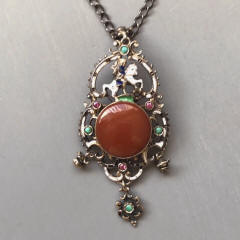 |
|
|
|
AUSTRO-HUNGARIAN St. George and the Dragon
necklace and pin combination with a smooth oval agate center with
turquoise, pink stones and enameling around, all set in800-900 silver. Renaissance
Revival in style, the enamel is in white,
black and green and some is missing here and there. The chain is
900 silver and it is 16" long and the pendant is
2-3/4" by 1-1/3". You can
go to Wiki to
read more about St George, a very interesting character in history.
View
View
View
View
View #Y42046 |
|
OTHER AUSTRO-HUNGARIAN PIECES
|
AUSTRO-HUNGARIAN SCENT BOTTLE– Says the owner of this wonderful piece:
"I’m attaching
photos of the Austrian Renaissance Revival scent bottle that I recently
acquired. I’ve been collecting for more than 25 years and this is the first
bottle that I’ve seen with this enameling “en ronde bosse”. I’ve had
several Austro-Hungarian bottles with just the raised jewels, but no
enameling. As I mentioned before, I’ve admired Renaissance jewelry for some
time and am pleased to have been able to acquire this extraordinary revival
piece.
"I think it dates to 1840-1860
time period. The only mark on the piece is a swan in an oval which
tells us nothing because it is a French import mark. It was at some time
sold at auction and was marked by the French to indicate it was a precious metal
– in this case, silver gilt." View View
View
View
View
View
View |
AUSTRO-HUNGARIAN SCENT
BOTTLE– "The stopper is a
double-sided head which is enameled. The shoulders and neck of the bottle
are decorated with hippocamp or hippocampus figures (hippocamp is a seahorse
type figure). The hippocamp is also repeated beneath the central figure on
both sides only upside-down. The Phoenix (mythological) figure is on one
side, and St. George and the Dragon (religious and historical) is on the
other.
"The chain was also embellished by the maker, as would have been the case in
the Renaissance, with additional figures — in this case the links are
hippocamps. At the top of the chain is a figure called a “mascaron” which
is a mask/face of some sort. Sometimes mascarons are grotesques, sometimes
funny, sometimes animal heads." |
AUSTRO-HUNGARIAN SCENT
BOTTLE-
A collector contacted me and was also kind enough to share
here her scent bottle, shown here.
|
|
AUSTRO-HUNGARIAN lovely
translucent enamel
on gilt sterling silver brooch with garnets and pearls, circa 1890. This shows the
distinctive white enamel with delicate brushwork typical of the
Transylvanian technique. See Moro’s "European Designer Jewelry" page
178.
View
View
View #V24857
|
AUSTRO-HUNGARIAN lorgnette of
gold washed 800 silver with enameling, citrines, emeralds and pearls, 5-1/2" by
1-1/4". The tiny mark "800" is on the glasses hinge and
this is from about 1890.
See this same piece in the book "Warman’s Jewelry, 3rd Ed", page 116,
by Christie Romero.
View
View
View
View
#L13478
|
VICTORIAN Austro-Hungarian lorgnette with quartz and mother of pearl set
in gold washed metal, illegible hallmark on the loop end, 9-1/2" by 2-1/4"
at the widest. The stones are roughly cut but do have a facet, and the
lorgnette itself is heavy and well made. The glasses pop out when a light
downward pressure is put on the button about 2/3 of the way down the handle.
This is an antique and elegant accessory from the past!
View
View
View
View
View
View
View #39416 |
|
AUSTRO-Hungarian Renaissance Revival dramatically colored enameled pendant with a wonderful purple
center stone surrounded by rose color and green rhinestones with purple, red
and green glass beads set off with white enamel work and set in gilt metal,
mostly copper.
See some wonderful Austro-Hungarian jewelry in Carole Tanenbaum’s book,
"Fabulous Fakes" on page 17. The beaded chain is 29" long
and the entire pendant portion itself is 3" by 1-3/4".
View
View #Q21461 |
HUNGARIAN gilt silver flower brooch with elaborate layered construction
featuring bezel set green and pink crystals, pegged natural garnet beads,
enamel flowers and cultured pearls, made in about 1920. Stamped on pin stem
in tiny letters it says, ‘Hungary’ with makers mark which looks like "KT",
an assay mark of a dog’s head, and "#3" for 800 silver, 3-5/8" by 1-1/2".The
"KT" mark may be the mark for the Kurcz Brothers.
View
View
View
View #Q31117
|
AUSTRIA enameled pendant with Spring green, black and white enameling,
marcasites and purple and topaz colored rhinestones all set in gold tone.
The chain has purple and yellow faceted glass beads and white enameled balls
along it in the Austro-Hungarian style. It has a 16" chain and
was
made in about 1915 and it is in excellent condition.
View
View
View #Q39287
|
AUSTRO-HUNGARIAN
locket with red paste, turquoise and pearls decorate the front as well as some very pale
enamel work. There are fittings inside for two photos and the locket is 1-1/4" by 1", and
the loop 5/8". The back has some finish differences as seen in the photo.
View
View #Q38355
|
AUSTRO-HUNGARIAN Renaissance Revival necklace with garnets, pearls and lovely delicate
poly-chrome enamel work on both the front and part of the back. It is 18" wearable length, the front element is 1-7/8" by 1",
and the element dangling from that is 7/8" by 1/2". A similar
piece can be seen in the book, "Warman’s Jewelry" 2nd Edition by
Christie Romero on page 72, and in her 3rd edition of the same book on page
117, where she dated that one to 1900, and then on page 143 is another
example dated 1920.
View
View
View
View #V38660 |
AUSTRO-HUNGARIAN bracelet with
sapphires and pearls set in silver, 8-1/3" by 3/4". t has
the Austrian dog’s head mark
(1872-1922), 800 silver, and mark "P" for Pest (Budapest), Hungary, city of
assay, maker’s mark "KT", circa late 1800s.
View
View
View #Q36404
|
|
AUSTRO-HUNGARIAN brooch and pendant necklace combination with pearls and
Persian turquoise set in silver with a sterling chain. The brooch has a chain attached to
wear as a necklace, or it can be worn as a brooch. The brooch is 1-1/2" by 1"
and the chain 20" with "sterling" marked on the clasp.
View
View #V37987
|
VICTORIAN Austrian Hungarian cherub locket with garnet marquis and turquoise
cabochons set into gilt silver metal with etched designs. The wonderful
detailed cupid or cherub is colorfully hand painted and fired onto a
porcelain oval. Inside, the locket has plastic covers for two photos,
The locket is 1-1/2" by 1-1/3". There are two tiny hallmarks on the top
loop of the locket but I cannot make out positively what they stand for. I believe one mark is the 1867-1922
mark for sterling silver, and the other mark could be a city mark. My
guess would be that this lovely locket is circa 1890. You can see the
Austro-Hungarian hallmarks on the wonderful reference site at
http://www.925-1000.com/Faustria_02.html "Hallmarking in
Austro-Hungary" www.925-1000.com.
View
View
View #V37874
|
AUSTRO-Hungarian pendant necklace with garnet cabochons, Persian
turquoise and a seed pearl chain set in silver metal, pendant
1-1/3" by 5/8", pearl necklace 15".
View
View #V37986
|
|
AUSTRO-HUNGARIAN
antique turquoise and amethyst necklace with three little seed pearls as
accents. Made between 1872 and 1890,
it is
Renaissance
Revival in style, 15-3/4" long and the
pendant portion is 1-7/8" by 1-1/3". It has a round box closure
and tiny hallmarks on the tongue of the clasp. One mark is "KL"
and the other too tiny for me to read, but it could be the dog mark and "3P" mark for 900 silver
with the Pest, Hungary, mark for the place of origin.
View
View
View
View
View
View #Y42044
|
AUSTRO-HUNGARIAN necklace and earrings with
natural amethysts, pearls and fresh water dog’s tooth Mississippi pearl
drops. Renaissance
Revival in style, if you look very closely
you can see two heads on the side,
hippocamps perhaps,
and above those are two flowers in vines. Made in about 1890, it
is 850 silver in the necklace and 750-800 silver in the earrings with
10k wires. The necklace is 17" long and the pendant portion is 2-1/2" by
1-5/8". The necklace catch is marked "sterling" in tiny letters.
The earrings for pierced ears are 3" long and 1" wide including the
fresh water dog’s tooth Mississippi pearl drops at the bottom.
View
View
View
View
View
View
View
View
View #Y42049
|
AUSTRO-HUNGARIAN cross pendant necklace of
purple stones, a shell center, and a chain with alternating pearls
and little faceted purple glass beads. Renaissance
Revival in style, it is set in gilt 900 silver,
and it is 16-1/2" long and the
cross is 2-1/4" by 1-3/4".
View
View
View
View #Y42048
|
|
AUSTRO-HUNGARIAN
garnet cross pendant necklace small tiny natural pearls and tiny touches of blue enamel, some of which is
missing, but it is visible only under magnified examination. It is set in 800 silver with a light gold wash and it is 1-5/8" by 1-1/4".
View
View
#Q42121
|
AUSTRO-HUNGARIAN
spectacular Victorian
natural amethyst necklace with alternating green emeralds, all but one green rhinestone
replacement. It is accented by black and white enameling with bits
of it missing upon very close examination.
Marked "935" for sterling silver on the clasp, it has a light
gold wash, and it is 16-1/2" wearable length and 3/4" at the
widest. It has little leaves, flowers and scrolls in the setting,
wonderful detail, and it also has the antique box style catch. View
View
View
View
#Q42118
|
AUSTRO-HUNGARIAN small round brooch with delicate white and aqua enamel
work
around the red stones and natural pearls, all in a gold washed base
metal setting. It has older European style tube closure and it is 1-1/8"
across.
View
View
#Q42120
|
|
AUSTRO-HUNGARIAN genuine AMETHYST Renaissance inspired necklace with
mother-of-pearl accents in a gold plated silver setting. The amethyst
is said to promote peace and calmness, which we could certainly use in
our world. It has the boar’s head hallmark on the clasp as well as the
mark "<12", the meaning of which we do not know. It is 16" wearable
length with a center element of 2" by 1-5/8". There is a nice layered
leaf design along with other designs, and the decoration runs all the
way up to the clasp. It is typical of this type of jewelry that it has
precious stones set in gold plated silver.
View
View
View
View
View
View
View
View
View #Q42298 |
AUSTRO-HUNGARIAN
citrine bracelet with lovely faceted oval citrines in a heavily gold
plated silver filigree setting. This lovely bracelet has seven links and is
7" by 3/4". The word "citrine" comes from a French word
for citrus or lemon and the citrine is supposed to be a stone that cleanses or
rejuvenates. It also signifies optimism.
View
View
View
View
View #Q42299 |
AUSTRO-HUNGARIAN Renaissance inspired rich blue rhinestone necklace with a combination of
both natural seed pearls and glass pearls, some of which form a halo around each stone.
The sapphire is said by some to be the wisdom stone that also enhances
creativity.
They are all in a gold plated
silver setting. The
wearable length of the necklace is 16" and the drop at the front is 3"
long. The three parts and the wonderful detail in this necklace makes it extra
special.
View
View
View
View
View
View #Q42297 |
|
|
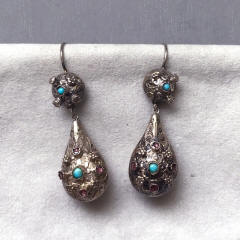
|
|
|
|
AUSTRO-HUNGARIAN Renaissance inspired turquoise and garnets earrings in an
800/1000
silver setting, 1-3/4" total length from the top of the wire to the bottom
of the earring and 1/2" at the most wide. The silver has lovely designs on
all the sides, and the two attached pieces create extra movement.
View
View
View #Q42296 |
|
|
AUSTRO-HUNGARIAN earrings with long oval
agate centers accented by turquoises and set in 850 silver with 10k ear
wires. For pierced ears, these
are 1-5/8" long, not counting the hooks, and 1/2" wide.
View
View
#Y42050
|
AUSTRO-HUNGARIAN Renaissance
Revival
pendant with red and green garnets, blue and white enameling and
mother-of-pearl all set in gilt silver, total length 3-3/4" and 1-3/4" wide on
a newer 24" chain. The detail is lovely and the piece beautifully made.
View
View #Q33281
|
AUSTRO-HUNGARIAN antique saber
or sword brooch with turquoise and garnets and an animal claw as the blade,
probably a large cat’s claw. Set in gold gilt 900 silver, the amazing detail around the stones on the
front, as well as on the gilt back side, add so much to this brooch. It is 2-1/2" by 1-1/4" and 1/4"
thick and it has the antique style tube and hinge closure. The tiny
marks on the pin say "JS" and also two other marks too tiny to for
me
read. View
View
View #Y42038
|
|
AUSTRO-HUNGARIAN antique sword in a sheath brooch with beautiful garnet
colored glass stones set in 800 silver. This
is two pieces attached by a chain, as can be seen in the photo, and it is
2-1/3" long. There are very tiny marks on the silver blade, one MAY be the
mark for Vienna, and the other unfortunately illegible. The applied decorative wire work on the front is absolutely
gorgeous.
View
View
View
View #Y42040
|
AUSTRO-HUNGARIAN Victorian antique brooch
with garnets, turquoise and one center garnet colored stone that is glass.
The setting are raised over a dome-shaped sphere. It has a mark that dates
it to 1867-1872 and it tests as 800-900 silver. Little flowers raised above the scrolls in the metal add wonderful
detail to this piece. The center stone is glass and the others are
garnets. Renaissance
Revival in style, there is a very tiny
hallmark on the back, too tiny to read, and it
has the antique style tube and c-clasp closure where the pin extends a
bit beyond the brooch edge. It is 2-1/3" wide and stands 7/8"
high.
View
View
View #Y42042
|
AUSTRO-HUNGARIAN Renaissance
Revival antique heart shaped garnets and seed pearls brooch with six heart-shaped garnets
around the edge and a round garnet in the center. Black enamel work
surrounds the stones on the front, and the back is equally detailed.
This is a 835 gilt silver setting and there are hallmarks on the pin, very tiny
and hard to read. One may
read "PV" and the other I cannot make out at all.
View
View #Y42041
|
|
RING Austro-Hungarian style ring with tiny turquoises and seed pearls in a
silver setting. Evan the back and the band are beautifully decorated!
Size 4, it is 7/8" by 5/8" on the front.
View
View
View
#V42078
|
AUSTRO-HUNGARIAN antique brooch with
four parts, all set with
turquoise, garnets and shell in 800 silver. It is enameled in blue and white and with a loop
at the top for a chain, should you want to wear it as a necklace. The
back is also enameled in different colors from the front, really lovely and
a very nice extra detail. One small garnet was replaced with another
garnet. Renaissance
Revival in style, the hallmarks are tiny and they appear on the
pin. They look like "AA" and another mark that looks like a backwards
"R" and an "H". It is 2-1/3" by 1-1/4".
View
View
View
View #Y42039
|
AUSTRO-HUNGARIAN Vienna Victorian antique
Renaissance revival
necklace of oval shaped links, each decorated by garnet colored glass stones, turquoise
and enamel work, which is cracked or missing in places upon close
examination. The necklace was made in
Vienna in about 1880-1890, and it is set in 850 silver. It is a wearable
length of 17" with each oval is 3/4" by 5/8". The tiny hallmarks
are on the tongue of the box closure.
View
View
View
View
View #Y42047 |
|
AUSTRO-HUNGARIAN
pendant necklace with green garnet doublettes
and natural pearls set in a
gold washed 875 silver setting and chain. It is 8" wearable length with a 1-1/3"
wide pendant.
View
View
View
View
#Q42119 |
AUSTRO-HUNGARIAN brooch with lovely enamel work in white, aqua and rose and aqua glass
beads, purple rhinestones and tiny cream colored beads, all set in a gold
washed bade metal setting. The brooch is 2" by 1-1/3" and it has wonderful detail.
View
View #V42117 |
AUSTRO-HUNGARIAN earrings with lovely
enamel work in white, aqua and rose and aqua colored glass beads, purple
rhinestones and tiny cream colored beads, set in gold washed base metal
settings. The
earrings are a total of 2" by 5/8" and they are screw backs.
View
View
View #V42117 |
AUSTRO-HUNGARIAN style pieces
marked Czechoslovakia
|
AUSTRO-HUNGARIAN Revival
brooch with pendant loop, rose cabochons, blue rhinestones and pearl
inserts, 1-5/8".
View #Q28382
|
AUSTRO-HUNGARIAN style (but probably Czech) simulated cameo necklace
with agate
cabochons, green beads, purple rhinestones and white enameling, 16"
necklace with 3-1/2" drop, circa 1920.
View
View
View #Q25010 |
CZECH
"CzechoSlovakia" marked multi-colored enameled and rhinestone 3-1/3"
pendant 22" chain in the Austro-Hungarian Renaissance Revival style, circa 1930s. View
#Q25337
|
|
CZECH cameo necklace and bracelet
with purple glass cabochons, chartreuse green enamel, and faux cameos, the
largest showing a dancing couple.
View
View
View
View
View #U5625 |
CZECH style pink and
green enameled necklace with pink cabochons, 24" chain 3" pendant. See
Czech pendants in Carole Tanenbaum’s "Fabulous Fakes" on pages 54-55.
View
#Q20905 |
PURPLE
enamel and
purple glass cabochon pendant with rhinestone accents set in gold tone.
View
View
View
View #Q17275 |
AUSTRO-HUNGARIAN STYLE PIECES
by other 20th Century Makers
|
CORAL Austro-Hungarian Revival
style screw-back earrings, each different, with turquoise and orange stones,
possibly agates, and white enameling, the right is 2-1/4" by 1-1/4"
and the
left is 2-1/8" by 1-1/3". Notice that while they look great together,
each earring is slightly different.
View
View
View
View
View
View
View #Q29738 |
AUSTRO-HUNGARIAN style
blue, green, purple and red enamel and rhinestone necklace, with green
cabochon center, 19" chain with a 3-1/2" pendant, circa 1920.
View #Q25009
|
AUSTRO
Hungarian Renaissance Revival style red white and black enamel, red rhinestone and
artificial pearl 7" by 3/4" bracelet, early 1900s. This shows the distinctive
white enamel with delicate brushwork of the Transylvanian technique, wonderful
detail. See Moro’s
"European Designer Jewelry" page 178.
View View
View #Y25070 |
HOBE red
and green cabochons, enamel and seed pearls 1-1/4" brooch and 1" earrings in
original box, circa 1950. This wonderful set in in the Renaissance
Revival style.
View
View #O27309 |
HOBE
Austro-Hungarian Renaissance Revival gold tone and polychrome colored enamel, cabochons and rhinestones 23" necklace with a
3-1/2" pendant and 1-1/4" earrings, circa 1950.
View
View
View
View #O26767 |
HOBE enameled and cabochons 18-1/2"
necklace with 1-1/8" pendant and 1-1/8" earrings, marked only on earring
backs. View
View
View
View
#O31108
|
HOBE Austro-Hungarian
Renaissance Revival style
pendant with blue, green and white enamel, green rhinestones and green and
topaz cabochons 19" chain and total 3" pendant and 1-1/8" clip back
earrings. View
View
View #O36001
|
HOBE Austro-Hungarian
Renaissance Revival matte
gold tone pendant necklace with rose cabochons, green rhinestones and
artificial pearls accented by red and white enamel and tiny blue dots,
necklace 17" long, pendant 2-3/4" wide. There is missing and slightly
cracked enamel but it can only be seen under a 10x loupe.
View
View
View
View #O34516 |
HOBE Austro-Hungarian revival fringed pendant and earrings,
black enamel on gold tone with aqua marbled cabochons, artificial pearls and
rose cabochons, chain 19-1/2", total front drop 3-3/4", earrings 1-1/8".
View #O35637
|
HOBE Renaissance Revival style bracelet with red, blue and
white enameling, blue cabochons and imitation pearls, gold tone chains and
fittings, wearable length 6-5/8" and 1-7/8" wide at the front.
View
View #O36767
|
HOBE necklace and bracelet with
green, yellow and white enameling, green cabochons and imitation pearls,
gold tone chains and fittings, necklace 18-1/2" wearable length and with a
2-3/4" drop, bracelet wearable length 6-5/8" and 1-7/8" wide at the front.
A similar piece can be seen in the book "Masterpieces of Costume Jewelry" by
Ball & Torem page 103 where this style is called the "Old World Art"
collection. View
View
View
View
View
View #O36769 |
HOBE Austro-Hungarian style locket
with blue, red and white enamel and blue cabochons 20" chain and 3/4" by
1-1/8" locket with fittings inside for photos but no photo covers.
View
View #O35475
|
HOBE brooch with green glass
cabochon, artificial pearls and enameling in red, white and black, 5
dangles, all set in matte gold tone, 2-1/4" by 2-1/4", some slight wear on 2
pearls. View #O37178
|
HOBE green and blue cabochons, artificial
pearls and black, white and yellow enamel earrings set in gold tone filigree
backs, 1". View #H34307
|
ARCANSAS
Austro-Hungarian style
red glass cabochons and rhinestones with tiny aqua beads and white enameling earrings
marked on the back "Arcansas" and "946". Arcansas
jewelry was made in the 1950s and 1960s by Elizabeth Reimer, a Hungarian
immigrant in Sydney, Australia. Her parents had been in the fine jewelry
business. View
View #Y25072 |
|
AUSTRO-HUNGARIAN Revival sterling
earrings with red and green rhinestones and artificial pearls, 7/8".
View #Q33976
|
AUSTRO-Hungarian revival necklace
with green rhinestones, glass pearls and little red cabochons set i an
antiqued gold tone setting on a decorated chain, wearable
length 24" necklace with a 2-1/3" by 1-1/2" rectangular pendant.
View
View #Q41175 |
FILIGREE Austro-Hungarian style rectangular pendant, with
colorful rhinestones set into a stamped gold colored metal backing, light
weight and with a loop at the top for a chain to slide through.
View #Y41362 |
|
HOLLYCRAFT brooch sterling vermeil
Austro-Hungarian revival style 2-1/8" by 3-1/4" brooch with aqua
glass and
red, green and clear rhinestones with artificial pearl accents and
enameling, circa 1946. This brooch is by John H. Hazard for Hollywood Jewelry
(Hollycraft), patent number 144,711.
View #Y24896
|
AUSTRO-HUNGARIAN style white,
aqua and yellow
enameled and red rhinestones bracelet marked "Arcansas" and "897", 7" by
1-1/3". Though it is mid-20th century, this revives the distinctive
white enamel with delicate brushwork typical of the older Transylvanian
technique. See Moro’s "European Designer Jewelry" page 178.
I have recently learned that Arcansas jewelry was made in the 1950s and 1960s by
Elizabeth Reimer, a Hungarian immigrant in Sydney, Australia. Her parents had
been in the fine jewelry business. She employed mostly women who, she thought,
had more delicate hands. The work on her jewelry is certainly delicate and
wonderful.
View
View
View
View
View #Q25035
|
AUSTRO-HUNGARIAN Revival earrings with green center rhinestones,
plastic pearls and white, aqua and black enamel work, all in a gold
washed base metal setting. These are 1-1/8" by 5/8" clip backs.
View
View #Q42123
|
|
REFERENCES:
"European Designer Jewelry", Chapter 5, by Ginger Moro
"Warman’s Jewelry" Edition 3, by Christie Romero
See Austro-Hungarian jewelry in Carole Tanenbaum’s "Fabulous Fakes" on
page 17.
Renaissance Jewels & Jeweled Objects published in 1968
by the Baltimore Museum of Art. The book catalogues the Melvin Gutman
Collection.
To read more about the history of Austro-Hungary 1867-1918 you can click
HERE to go to Wiki.
|
 |
|

